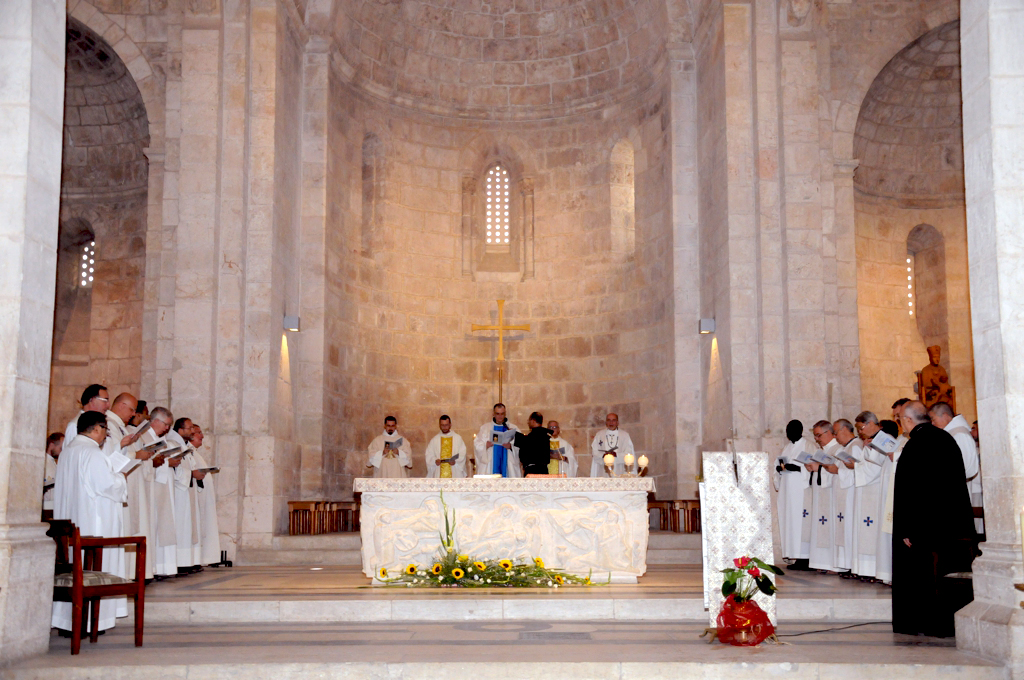
Solemn Feast celebrated at the Basilica of St. Anne in Jerusalem
Mass was celebrated in the beautiful Church that stands next to the pool of Siloam, currently managed by the White Fathers. The main celebrant was Fra Stéphane Milovitch, Guardian of the Basilica of the nativity in Bethlehem. Concelebrants included Fra Artemio Vitores, Custodial Vicar and Fr. Bill Russell, Superior of the Missionaries of Africa, also known as the White Fathers. Many friars, priests, religious, local faithful and pilgrims visiting the Holy Land attended the celebration. Also present was the French Consul General, MrFrederic Desagneaux.
In his homily Fra Stéphane noted that Pope Sergius I introduced this Feast (VII Century), following the tradition of the Eastern [Church]. The Nativity of the Virgin Mary is closely linked to the coming of the Messiah, as promised, the preparation and fruit of salvation. He emphasized the importance of the festival in Jerusalem, the cradle of the three monotheistic religions and on the unifying roll that Mary plays not only for Christians, but also for Jews and Muslims.
Prior to Mass, the celebrants incensed the icon of the Nativity of Mary, located in the cave beneath the Basilica. According to tradition, this place was the house of Joachim and Anne, the parents of Mary.
Origins of the Feast
The oldest source accepted by the Church as reliable illustrating the birth and childhood of Mary is the “Protogospel”of James, dating from the Second Century A.D. The text illustrates the highlights of the life of Mary: The marriage of her parents, Joachim and Anna, from the tribe of Judah and of the seed of Achar, the conception after twenty years without offspring, the birth and presentation in the temple. These are facts inserted in the historic framework of the city of Jerusalem.
The fate of the birthplace of Mary is not separated from that suffered by the city of Jerusalem, with persecutions, destruction of the temple, transformation into a place of pagan worship, expulsion of the Jews, etc.
It is due to Helen, mother of Emperor Constantine, that Christians were granted liberty to worship in Jerusalem when, in the first half of the Fourth Century, excavations revealed the ruins of a chapel on the site that tradition indicated to be the birthplace of Mary.
With the Third Council of Ephesus in 431, which authoritatively declared Mary as the “Mother of God”, other Marian feasts flourished in the liturgical calendar, including: the Nativity, the Presentation in the Temple, the Annunciation and the Dormition.
The date (September 8th) of the Feast of the Nativity of Mary was fixed in the first half of the Fifth Century, during the time of Patriarch Juvenal and empress Eudoxia. The Basilica of Santa Maria, build on the site of the birthplace of Mary, was dedicated on that day.
Mass was celebrated in the beautiful Church that stands next to the pool of Siloam, currently managed by the White Fathers. The main celebrant was Fra Stéphane Milovitch, Guardian of the Basilica of the nativity in Bethlehem. Concelebrants included Fra Artemio Vitores, Custodial Vicar and Fr. Bill Russell, Superior of the Missionaries of Africa, also known as the White Fathers. Many friars, priests, religious, local faithful and pilgrims visiting the Holy Land attended the celebration. Also present was the French Consul General, MrFrederic Desagneaux.
In his homily Fra Stéphane noted that Pope Sergius I introduced this Feast (VII Century), following the tradition of the Eastern [Church]. The Nativity of the Virgin Mary is closely linked to the coming of the Messiah, as promised, the preparation and fruit of salvation. He emphasized the importance of the festival in Jerusalem, the cradle of the three monotheistic religions and on the unifying roll that Mary plays not only for Christians, but also for Jews and Muslims.
Prior to Mass, the celebrants incensed the icon of the Nativity of Mary, located in the cave beneath the Basilica. According to tradition, this place was the house of Joachim and Anne, the parents of Mary.
Origins of the Feast
The oldest source accepted by the Church as reliable illustrating the birth and childhood of Mary is the “Protogospel”of James, dating from the Second Century A.D. The text illustrates the highlights of the life of Mary: The marriage of her parents, Joachim and Anna, from the tribe of Judah and of the seed of Achar, the conception after twenty years without offspring, the birth and presentation in the temple. These are facts inserted in the historic framework of the city of Jerusalem.
The fate of the birthplace of Mary is not separated from that suffered by the city of Jerusalem, with persecutions, destruction of the temple, transformation into a place of pagan worship, expulsion of the Jews, etc.
It is due to Helen, mother of Emperor Constantine, that Christians were granted liberty to worship in Jerusalem when, in the first half of the Fourth Century, excavations revealed the ruins of a chapel on the site that tradition indicated to be the birthplace of Mary.
With the Third Council of Ephesus in 431, which authoritatively declared Mary as the “Mother of God”, other Marian feasts flourished in the liturgical calendar, including: the Nativity, the Presentation in the Temple, the Annunciation and the Dormition.
The date (September 8th) of the Feast of the Nativity of Mary was fixed in the first half of the Fifth Century, during the time of Patriarch Juvenal and empress Eudoxia. The Basilica of Santa Maria, build on the site of the birthplace of Mary, was dedicated on that day.

